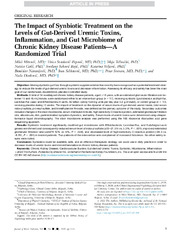Приказ основних података о документу
The impact of synbiotic treatment on the levels of gut-derived uremic zoxins, inflammation, and gut microbiome of chronic kidney disease patients - a randomized trial
| dc.creator | Mitrović, Miloš | |
| dc.creator | Stanković-Popović, Verica | |
| dc.creator | Tolinački, Maja | |
| dc.creator | Golić, Nataša | |
| dc.creator | Soković Bajić, Svetlana | |
| dc.creator | Veljović, Katarina | |
| dc.creator | Nastasijević, Branislav J. | |
| dc.creator | Soldatović, Ivan A. | |
| dc.creator | Svorcan, Petar | |
| dc.creator | Dimković, Nada | |
| dc.date.accessioned | 2023-03-09T13:27:54Z | |
| dc.date.available | 2023-03-09T13:27:54Z | |
| dc.date.issued | 2023 | |
| dc.identifier.issn | 1051-2276 | |
| dc.identifier.uri | https://vinar.vin.bg.ac.rs/handle/123456789/10699 | |
| dc.description.abstract | ObjectiveAltering dysbiotic gut flora through synbiotic supplementation has recently been recognized as a potential treatment strategy to reduce the levels of gut-derived uremic toxins and decrease inflammation. Assessing its efficacy and safety has been the main goal of our randomized, double-blind, placebo-controlled study.MethodsA total of 34 nondialyzed chronic kidney disease patients, aged ≥18 years, with an estimated glomerular filtration rate between 15 and 45 mL/minute, were randomized either to an intervention group (n = 17), receiving synbiotic (Lactobacillus acidophilus, Lactobacillus casei, and Bifidobacterium lactis, 32 billion colony forming units per day plus 3.2 g of inulin), or control group (n = 17), receiving placebo during 12 weeks. The impact of treatment on the dynamic of serum levels of gut-derived uremic toxins, total serum indoxyl sulfate, p-cresyl sulfate, and trimethylamine N-oxide, was defined as the primary outcome of the study. Secondary outcomes included changes in the stool microbiome, serum interleukin-6 levels, high-sensitivity C-reactive protein, estimated glomerular filtration rate, albuminuria, diet, gastrointestinal symptom dynamics, and safety. Serum levels of uremic toxins were determined using ultraperformance liquid chromatography. The stool microbiome analysis was performed using the 16S ribosomal ribonucleic acid gene sequencing approach.ResultsSynbiotic treatment significantly modified gut microbiome with Bifidobacteria, Lactobacillus, and Subdoligranulum genera enrichment and consequently reduced serum level of indoxyl sulfate (ΔIS –21.5% vs. 5.3%, P < .001), improved estimated glomerular filtration rate (ΔeGFR 12% vs. 8%, P = .029), and decreased level of high-sensitivity C-reactive protein (–39.5 vs. –8.5%, P < .001) in treated patients. Two patients of the intervention arm complained of increased flatulence. No other safety issues were noted.ConclusionSynbiotics could be available, safe, and an effective therapeutic strategy we could use in daily practice in order to decrease levels of uremic toxins and microinflammation in chronic kidney disease patients. | en |
| dc.language | en | |
| dc.rights | openAccess | |
| dc.rights.uri | https://creativecommons.org/licenses/by-nc-nd/4.0/ | |
| dc.source | Journal of Renal Nutrition | |
| dc.subject | Cardiovascular Burden | en |
| dc.subject | Chronic Kidney Disease | en |
| dc.subject | Gut-derived Uremic Toxins | en |
| dc.subject | Inflammation | en |
| dc.subject | Microbiome | en |
| dc.subject | Synbiotic | en |
| dc.title | The impact of synbiotic treatment on the levels of gut-derived uremic zoxins, inflammation, and gut microbiome of chronic kidney disease patients - a randomized trial | en |
| dc.type | article | |
| dc.rights.license | BY-NC-ND | |
| dc.citation.volume | 33 | |
| dc.citation.issue | 2 | |
| dc.citation.spage | 278 | |
| dc.citation.epage | 288 | |
| dc.identifier.doi | 10.1053/j.jrn.2022.07.008 | |
| dc.type.version | publishedVersion | |
| dc.identifier.scopus | 2-s2.0-85148357328 | |
| dc.identifier.fulltext | http://vinar.vin.bg.ac.rs/bitstream/id/28178/1-s2.0-S1051227622001522-main.pdf |
Документи
Овај документ се појављује у следећим колекцијама
-
050 - Laboratorija za fizičku hemiju
Department of Physical Chemistry -
Radovi istraživača
Researchers' publications

